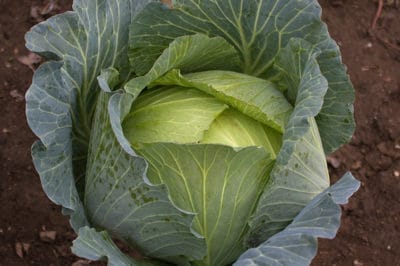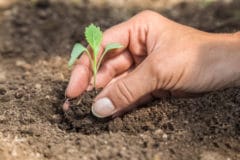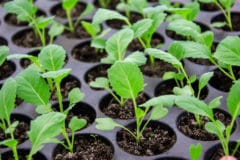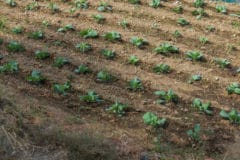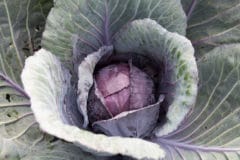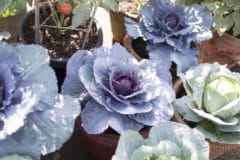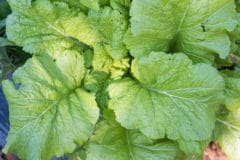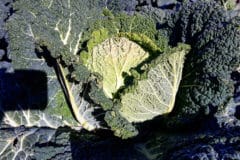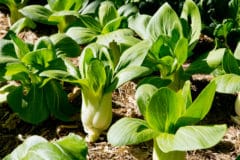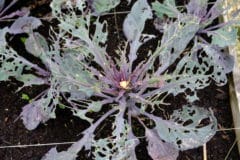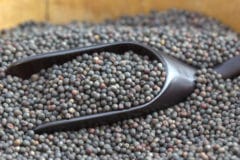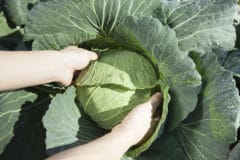How Soon Can I Plant Cabbage?
Cabbage is a cool season crop, so you can plant it earlier than many other vegetables. You can purchase seedlings to transplant, but it’s very easy to start cabbage from seeds yourself.
For your first planting in the spring, start your seeds indoors six to eight weeks before the last frost date for your area if you plan to grow your own seedlings.
If you plan to sow your seeds directly in the garden, wait until two weeks before the last frost date in your area.
Transplant seedlings two to three weeks before the last frost date for your season, preferably on a cloudy afternoon.
Delaying planting by a week or two, if possible, thwarts cabbage pests who emerge looking for a meal, expecting your cabbage to be there waiting for them.
Check with your local extension service if you are uncertain about the last frost date for your area.
To maintain a continuous harvest, you can replant seeds every two weeks outdoors as temperatures warm.
How Do I Plant Cabbage Seeds?
When you are starting your seeds indoors, plant them 2 inches apart and 1/4 inch deep. If you are sowing your seeds outdoors for your initial spring planting, space them 2 inches apart but 1/2 inch deep. For later outdoor plantings, space seeds 6 inches apart.
After planting, keep the soil evenly moist. If you are starting them indoors, place them in a sunny location or under either grow lights or cool, white florescent lights.
What Should I Do to Prepare Cabbage Seedlings for Transplanting?
One to two weeks before you intend to transplant your seedlings for spring planting, begin hardening them off or giving them time to adapt to the conditions outdoors.
When your seedlings have two to three pairs of leaves and temperatures climb to around a steady 50°F (10°C), water them and then move them outdoors to a sheltered area, such as a cold frame or an unheated greenhouse, for two hours on a cloudy afternoon. You also can place your pots or flats of seedlings in crates, boxes, or other containers to protect them from wind and pests like grubs.
The next day, extend the time outdoors by two more hours, for a total of four hours, with one hour of that time in full morning sun. On each successive day, extend the total time your cabbage is outdoors and the hours of full morning sun. Eventually, you can leave your cabbages out over night as long as there is no danger of frost.
How Do I Transplant Cabbage Seedlings Outdoors?
For your initial spring planting, space your seedlings 6-12 inches apart in rows that are 1-2 feet apart. Dig a hole for each seedling that is deep enough to bury 1-2 inches of the stem.
The distance between your seedlings determines the size of the cabbage head. If you want medium-size heads, keep your seedlings 12 inches apart. If you want both large and small heads, space your seedlings 6 inches apart and harvest every other one, allowing the remaining heads to grow to full size.
For varieties of cabbage with larger heads, wait until your plants are about 5 inches tall, and then thin them to 24 inches apart. Instead of discarding the thinned plants, transplant them to another area of your garden.
How Do I Prepare My Soil for Growing Cabbage?
Cabbage draws large amounts of nutrients from the soil and is especially prone to yellow leaves from low nitrogen, so have your soil tested by your local extension service.
Add lime, if needed to bring the pH level up to between 6.5 and 6.8.
Increase levels of other nutrients by working a 2-inch layer of compost or composted manure and a balanced, time-released, 14-14-14 vegetable food into the soil.
Either cottonseed meal, blood meal, or a compost tea adds nitrogen to the soil, and kelp meal adds minerals and other micronutrients.
What Type of Soil Does Cabbage Prefer?
Because cabbage requires high levels of nutrients, it needs very rich soil. Varieties of cabbage for early harvesting prefer sandy or loamy soil while late growing varieties prefer heavier, moisture-retaining clay soils, but all varieties appreciate a well-drained location that does not remain muddy or collect puddles.
What Temperatures Are Best for Growing Cabbage?
Cabbage seeds germinate best when temperatures are between 65-75°F (18-24°C), but cabbage plants grow well at temperatures ranging from 39-75°F (4-24°C).
What Type of Lighting Does Cabbage Prefer?
Cabbage prefers full to partial sun. If you plan to stagger your planting to plant new cabbage every two weeks for harvesting throughout the summer, plant your initial crop where it will receive full sun, but consider protecting later crops by choosing locations where it will be partly protected from increasing temperatures by taller plants such as pole beans or corn.
How Do I Water Cabbage?
Cabbage needs 2 inches of water per week, but it needs to be applied evenly. Even watering helps cabbage heads fill out evenly. Uneven watering can result in growth spurts that can cause cabbage heads to split.
Avoid getting water on cabbage leaves during periods of high humidity or extended periods of cool weather. Use a soaker hose for watering. Leaves that remain wet are at risk for disease.
Placing mulch around your cabbage will help the soil retain moisture.
When Should I Apply Organic Fertilizers to My Cabbage?
Apply a side-dressing of rich compost around your cabbage three weeks after you plant it, and then apply more every three weeks thereafter.
What Diseases Affect Cabbage?
Cabbage is subject to:
- Fusarium wilt, also called “the yellows”, which results in stunted heads and yellow leaves.
- Club root which prevents roots from absorbing soil nutrients and water.
- Black leg, a fungus that creates dark spots on cabbage stems and leaves.
- Black rot which results in foul-smelling black veins on the leaves.
If any of your heads of cabbage show signs of any of the above diseases, remove them from your garden and destroy them to prevent the disease from spreading to healthy plants. Repeated problems with club root is a sign that your soil’s pH level is too low. Test your soil and add limestone to bring pH up to a minimum of 6.8.
In addition, either remove all the remaining vegetation from your garden at the end of the growing season or work it into the soil.
Finally, rotate cabbage and its near relatives – kale, cauliflower, broccoli, collards, and Brussels sprouts – with unrelated plants every year to prevent recurrences of these diseases as well as recurrences of insect infestations.
What Insects Attack Cabbage?
The insects that attack cabbage include:
- Harlequin bugs – small shiny black insects with red markings that cause wilting leaves and black spots on the plants.
- Slugs – eat ragged holes through the leaves.
- Cutworms – nocturnal caterpillars that feed on stems and foliage at night and that tunnel underground during the day to feed on roots.
- Imported cabbageworm – the green caterpillar of the imported white cabbage moth.
- Cabbage looper – another green caterpillar that devours cabbage leaves.
You have several options that will protect your cabbage from these interlopers:
- If you notice slugs, harlequin bugs, or these worm-like caterpillars feasting on your cabbage leaves, you can pick them off by hand.
- Row covers, if closed immediately after you plant your cabbage, prevent moths from laying their eggs on your cabbage so that the caterpillars never hatch there to feed on it.
- Diatomaceous earth sprinkled around your cabbage will pierce the bodies of any soft-bodied insects or caterpillars that crawl over it and cause them to become dehydrated and die.
- Homemade sprays of insecticidal soaps, tomato leaf spray, and garlic oil spray control aphids and other cabbage pests.
- Certain companion plants, such as bittercress, lure moths away from your cabbage while other companion plants, such as thyme, repel the imported cabbage white moth.
How Do Companion Plants Help Cabbage?
As already mentioned, some companion plants, like rosemary, thyme, and marigolds repel the imported white cabbage moth while tansy repels the imported cabbageworm and cutworms. Nasturtiums, on the other hand, will lure aphids from any other plant in your garden.
Garlic, dill, celery, and onions, among others, enhance the flavor of your cabbage.
Yarrow gives a double boost to any plants growing near it by repelling harmful insects while adding nutrients to the soil.
What Plants Hinder Cabbage’s Growth?
While they aren’t directly harmful to cabbage, it’s closely related siblings, cauliflower and broccoli, share cabbage’s trait of drawing large quantities of nutrient from the soil. If these three are planted too closely together, the soil might not be able to support their growth.
How Do I Know That My Cabbage Is Ready for Harvesting?
Your cabbage is ready for harvest when the head has reached the expected size and when it feels solid and firm.
How Do I Harvest My Cabbage?
To harvest cabbage, use a sharp knife to cut the cabbage from the stem at the base of the head. To obtain a second harvest from early varieties of cabbage, remove the head while leaving the root and the outer leaves.
When new heads appear, leave about four, pinching the others off of the stem. Harvest the remaining heads to use in salads when they are approximately tennis ball size.
After the second harvest, remove the root and stem from the ground to avoid attracting pests and diseases. If the plant is healthy, add it to your compost.
Can I Store My Cabbage?
You can store cabbage leaves in a plastic bag in your refrigerator for about two weeks, but you can store cabbage heads in a root cellar for as long as three months. Chinese cabbage can be preserved as kimchi while green cabbage can be made into sauerkraut.
